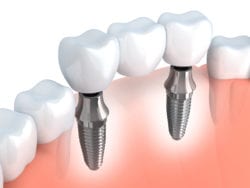Dental Bridges An Overview
A dental bridge can restore function and aesthetics when one or several consecutive teeth are missing. Traditionally a dental bridge was a removable oral appliance. However, today’s patients can enjoy the benefits of a fixed bridge that is permanently secured using dental implants or natural teeth strengthened by dental crowns. A dental bridge can be designed and placed in 2-3 visits with Dr. Chahal at Foothills Dentistry in Calgary. Visit our friendly restorative dentistry for your dental needs.
Replacing your missing teeth with a dental bridge will support your long-term dental health and your best quality of life. Dr. Chahal works with patients who have missing teeth to re-establish a healthy, comfortable and functional smile through personalized treatment.
Dental Bridge vs Dental Implant: What to consider
 When it comes to replacing a single tooth, a dental bridge or a dental implant remain the common options for most patients. Dr. Chahal will provide a recommendation based upon her exam and your overall needs, but there are several important points to consider when weighing the options.
When it comes to replacing a single tooth, a dental bridge or a dental implant remain the common options for most patients. Dr. Chahal will provide a recommendation based upon her exam and your overall needs, but there are several important points to consider when weighing the options.
- Stable and permanent solution: a dental implant is secure and permanent, replacing your lost tooth with natural function and aesthetics.
- Minimizes changes in the jaw: by replacing the tooth root structure, a dental implant supports and stabilizes jaw bone tissue where the lost tooth was located, minimizing bone loss and shrinkage of the jaw.
- Cost and time investment: initially a dental implant will most likely be more costly and time-consuming. However, in the long run a permanent solution that will remain as stable as a natural tooth and restore the most natural chewing function and speech. Dental implant treatment will also take longer to complete. However, it requires healing time which makes it more durable and stable.
